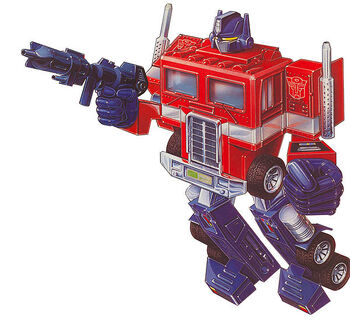
Box art for Optimus Prime in 1984.
Throughout the life of the Transformers brand, package art has been one of its most common elements. Though not as widely noted and celebrated as Tech Specs, it is just as enduring and iconic to the brand. In the fandom, it is also referred to as box art, though it also appears on carded toy packages.
Transformers package art most often serves to portray the toy in the mode that it isn't packaged in. As most Transformers are sold in their non-robot forms, it typically shows them as robots (or whatever their equivalent primary mode is.)
Generation One[]
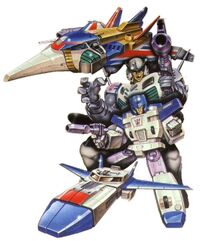
And if you complain once more, you'll meet an army of me.
Every Transformer sold in Generation One featured hand-painted artwork on the front of the package, most often showing the robot mode, with the vehicle form of the actual toy visible alongside it through a clear plastic window or bubble. A smaller version of the art was shown as part of the character's biography and Tech Spec profile.
Some toys would also have art depicting their vehicle mode. The Jumpstarters had vehicle art because they were packaged in robot mode, and the Triple Changers had art for the vehicle mode the toy wasn't packaged in. The tech specs still used the robot art only. Punch also had boxart for both of his robot modes. Another exception to the rule was the Clones, sold packaged in their identical robot modes, with artwork of their different alternate modes alongside them. Vehicle mode art was generally used only on windowed boxes, since the non-windowed boxes (such as Omega Supreme, Metroplex, Fortress Maximus, and Countdown) had large pictures of all alternate modes on the front.
Package art for the multiple-form Pretenders featured all of their forms: outer shell and both modes of the inner robot. As the multiple-form Mega and Ultra Pretender toys came along, this resulted in some rather crowded package art.
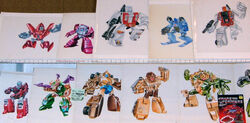
When we win the lottery, this is where we're going.
The character art for many of the Diaclone-licensed characters was directly appropriated from their original Diaclone boxes, including Autobot vehicles, Dinobots, and Decepticon cassettes. This style was maintained for all newly-commissioned Generation One (and Generation 2) character art, presumably for consistency.
This art style often depicted a somewhat fictionalized version of the robot mode. While the reproduction of the toy's finer details was done very faithfully, the actual poses were often utterly impossible to reproduce given the limited articulation of most Generation One toys. Seemingly, the less the posable the toy was, the greater the artistic exaggeration tended to be; thus, the Throttlebots and Battlechargers were shown with jointed arms, separable legs and posable heads, even though the represented toys lacked all these features.
A large portion of the 1986 through 1988 character line art was done by Richard Marcej, including some if not all of the Predacons, Headmasters, Targetmasters, Powermasters, Seacons and Pretenders. Much of the late-run Generation One package art was the work of Japanese illustrator Hidetsugu Yoshioka, whose work brought a dynamic and appealing style to the often blocky and simplistic toys.
A number of the original Generation One paintings have appeared for sale at recent BotCons, at asking prices starting at $650 and ranging up to several thousand dollars.
Back of the box art[]
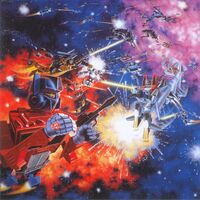
My name is Optimus Prime. I'm Japanese!
For the first five years, the boxed toys of Generation One also featured hand-painted, mural-like artwork depicting that year's toyline engaged in battle.
Compared to the fiction which developed around the toys, these paintings often feature some rather surreal elements. Multiples of the same character are shown (sometimes to depict movement, and possibly a result of the Transformers toys' original fictional origin as piloted mecha), and cars are seen to fly through space. Occasional off-model characters appear as well, such as a red Tracks or a strange-looking Broadside.
The original 1984 painting showed the Transformers battling in deep space. The 1985 toy assortment was shown fighting in Earth orbit, with the planet sustaining some massive damage below them. In 1986, they were on the barren surface of a planet, centered around Metroplex. The 1987 battle was once again in deep space, with Fortress Maximus and Scorponok as the clear centerpieces; 1988 was likewise set in deep space.

I'll finish you yet, Dudley Do-Right!
With the proliferation of Pretenders and Micromaster bases in 1989, the standardized back-of-box art was replaced with a series of rather crude and cartoonish hand-drawn scenes, each showing a few of that year's characters engaged in combat, typically the toy type (Micromaster base, Mega Pretender, etc.) that was being sold in the package. The line art for these illustrations was apparently all done by Richard Marcej [1], who was creditably also responsible for much of the higher-quality character art from earlier years.
The Action Masters in 1990 did get a more traditional mural painting, showing a battle in low Earth orbit, complete with ground vehicles flying through space.
Generation 2[]
Generation 2 featured a combination of retouched (or redrawn-to-look-as-if-it-were-retouched) Generation One (obviously for the repainted or retooled Generation One toys) and all-new artwork to accompany the new toys. This new artwork was closer in resemblance to the artwork seen in the last years of Generation One than the early art.
Beast Wars[]
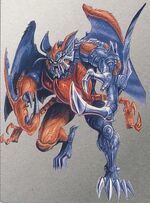
The Batclaw.
Beast Wars continued the painted-art standard of Generation One, though the artwork tended to exaggerate the beastly qualities of the robot modes. Occasional use of the mutant head feature on the early Beast Wars toys sometimes led to rather strange results.
The Japanese releases mostly used very toy-accurate CGI boxart. The only exceptions were the characters from the American Beast Wars show (which used more show-accurate art than their American counterparts) and the Auto Rollers (who had traditional-style box art).
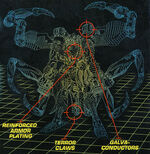
Terror Claws, the nemesis of Echowarrior.
Three of the largest Beast Wars toys (the Transmetals Depth Charge, Rampage and Optimal Optimus) featured a "schematic" drawing of the toy in robot mode on the back of the box, in blue line-on-black form, alongside a photograph of the actual toy. The drawing had call-outs for such technical details as "galva-conductors", "terror claws", "space cruiser wings", and "LED smart missile plasma cannons".
The later Transmetal 2 toys Tigerhawk and Megatron omitted the line art and used the toy photo to call out the techno-nonsense. These two toys also featured added box art placed so that the toys, visible through the box's plastic window, appeared to be firing their weapons. Megatron, for example, appeared to have a stream of fire spewing from his dragon head's mouth.
Machine Wars[]
Machine Wars was comprised of mostly repaints/retools from the 1992 European Generation One toyline and previously unused Generation 2. The only packaging art created for the line was the art for Hubcap and Hoist. Sandstorm, Soundwave and Starscream used art from the Generation One toys they were redecoes of. The Basic jets used recolored Predator art, and Prowl and Mirage used Laser Rod Jolt's art. Oddly, Optimus Prime didn't use Thunder Clash's art, but instead used a heavily edited version of Laser Optimus Prime's art.
Beast Machines[]
The Beast Machines toyline was the first to break with the tradition established by Generation One. Most packages featured the CGI-rendered robot mode of Cheetor, rather than the character whose toy was being sold. For the "The Battle for the Sparks" subline, Cheetor was replaced by Optimus Primal in beast mode. The "Dinobots" subline featured T-Wrecks in beast mode.
The CGI model of boxed characters who appeared on the show, such as Tankor, appeared on the back of their boxes alongside their profile.
Robots in Disguise[]
Robots in Disguise restored individual character portrayals to the front of packages... but these were simply computer-enhanced photographs of the actual toys within, often transformed to varying degrees of accuracy. The Japanese Car Robots releases continued to use the type of CGI boxart used on the Japanese Beast Wars toys.
Armada[]
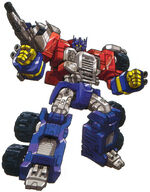
Obesity is my destiny!
With the new Armada toyline and franchise continuity, Hasbro's Transformers packaging returned to hand-drawn character art for the first time since the end of Beast Wars. Drawn by artists from Dreamwave Productions, this art followed a comic book style with modern Photoshop colouring, rather than the hand-painted work of Generation One.
This art was also reproduced onto a collectible sticker that was included with all Armada toys from the Super-Con size class and upwards.
- The Mini-Con class toys featured a single piece of artwork of one of the Mini-Con team members on the insert tray card
- The Super-Con class toys did not feature artwork directly on the packaging card itself, instead opting to display the collector sticker in the packaging bubble.
- Max-Con, Giga-Con, Super Base and Supreme class toys all featured art directly printed onto the packaging.
Commemorative Reissues[]
The Generation One Commemorative Reissue series featured a wide range of previously seen art, from the original 1980s packaging art to the Transformers Collection reissue artwork by Hirofumi Ichikawa. Additionally, all-new art by Dreamwave artist/president Pat Lee was commissioned for several of the later reissues, coupled with a few instances of recycled artwork originally drawn by Lee for the covers of Dreamwave's first Generation One mini-series.
Universe[]
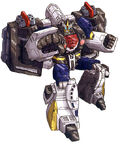
Hey! Come back with my purse!
Universe packaging art were mostly by the Dreamwave affiliated artists, but while the penciling was of the same general quality and style of the mainline art, the colouring was often much flatter and lacking in depth. Additionally, some toys featured artwork by Hasbro's in-house artists attempting to emulate the then-popular Dreamwave style, to extremely varied results.
Energon[]
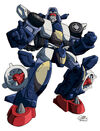
Hahahaha, I've got your purse!
The Energon toyline featured the same style of comic artwork first seen in the Armada line, this time featuring all of the characters included in a toy package where possible (for example, an entire Mini-Con team as opposed to just a single member as seen during Armada). Once again, artists affiliated with Dreamwave Productions provided the artwork. Similarly to Armada, for toys Deluxe class and upwards the packaging art was reproduced on collectible tech spec cards included with paperwork or taped inside the packaging bubble. The Japanese boxes had different artwork and had a more show accurate design.
Alternators[]

Combaticon Night Fever
The Alternators toyline originally featured the same style of full-body artwork seen in the other Transformers toylines at the time, once again by various Dreamwave artists (namely Pat Lee, Don Figueroa, Alex Milne, Joe Ng, Guido Guidi and Marcelo Matere). However, when the packaging style switched to the large plastic bubble/cardboard tray configuration in late 2005, the packaging art style—now entirely drawn by Marcelo Matere—was changed to emulate the focused upper torso style seen in the Cybertron toyline, though the art was coloured more closely to the comic book style.
Cybertron[]

It's gonna be a Cybertronsical Tranformertastic Snit in the Pit! Only $49.95 on Pay-Per-View!
Cybertron's packaging artwork headed in a dramatically different direction to the previous years, dropping the comic book style in favour of focusing on the upper torso of the character while they were in a 'ready to fight' pose, similar to the advertising posters of boxing matches. The artwork was drawn mostly by now-freelance ex-Dreamwave artists, and coloured in a style passably similar to the painted Generation One/Generation 2 art.
Classics[]
Similarly to Robots in Disguise, the Classics toyline was created as a 'filler' line, to plug the gap between the end of Cybertron and the beginning of the 2007 live action movie toyline. As such, Hasbro once again returned to using photographs of the toys instead of actual drawn artwork.
Robot Heroes[]
Robot Heroes featured extremely cute super deformed-style artwork of the figures.
Transformers (2007)[]
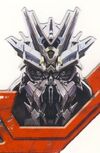
Like most movie characters, he could stab you with his head.
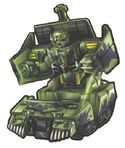
Cyber Slammer Brawl, adorable death machine.
The majority of the "main line" toys from the 2007 movie toyline featured a very exactingly detailed mugshot of the character (seemingly hand-painted), surrounded by technological greeblies. The characters featured in the film appear to use the movie models as a starting point, though there are some difference in coloration and detail.
In Europe, this art was replaced by a photo of the toy in robot mode, which was also used on the rear of the packaging. Some of this art (as well as the packaging design) was also used by several licensed merchandise manufacturers.
The Fast Action Battler and Cyber Slammer sublines had traditional hand-drawn art, but done in a more rounded, 'cuter' style to fit the younger target age group of the toys.
The Real Gear Robots opted to use a closeup photograph of the toy's upper torso, similarly to Classics, while the Target-exclusive Scout class range of repaints lacked any sort of packaging art.
Transformers Animated[]
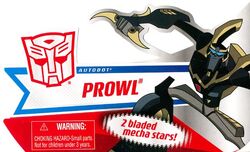
Three annoying companions, two bladed mecha stars, and a ninja in a park tree.

Grumpy old bot for sale.
The Transformers Animated line predominantly uses character model and promotional images for the actual Transformers Animated cartoon, which is a first for the North American Transformers toyline.
The Deluxe packaging features a large image of the character, showing the bulk of their body and generally in an action pose, on the front of the plastic packaging bubble. A different image is used as a smaller mug shot on the side of the bubble and on the back of the card by their quote, possibly making Animated the first series to give each toy two unique pieces of character package art.
This layout is replicated for the Voyager size-class toys, though obviously the front and side images are printed on exterior cardboard.
Universe (2008)[]
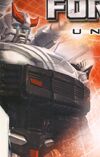
DO NOT WANT
The all-new Universe sees a return of comic book-style packaging art, with an upper torso drawing of the character printed either on the carded package or the box. To the amusement of all, some of the art also sees a return of the glassy-eyed, slack-jawed expressions first seen during the days of Dreamwave Productions. Artist Marcelo Matere commented on his deviantART page that Hasbro had requested a more static, statue-like depiction for this line.
Europe[]
For a long time, European packaging featured the same box artwork as the toys' respective North American versions (and, in the case of the European exclusive toys from the early Nineties, its own unique artwork). However, during the last waves of Energon (specifically, beginning with the second wave of the Superion Maximus limbs), the box artwork was replaced by photos of the toys themselves on European packaging. The same happened with the Alternators packaging starting with Windcharger and Swindle. From then on, European Transformers packaging omitted any artistic renditions of the toys in favor of strictly accurate depictions of the products themselves (at least as "accurate" as Hasbro's early hand-painted/airbrushed prototype stock photography can be). With the advent of Animated, however, this policy was abandoned, and artwork of the characters returned.
Merchandise[]
Transformers Tapestry[]
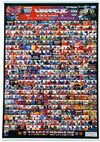
Holy...
The e-Hobby New Year Special 2008 Transformers Tapestry is a 750mm x 615mm wall scroll that was released in spring 2008. It featured head and bust shots of the box art of every Transformer released in Japan from 1984 until 1995.
